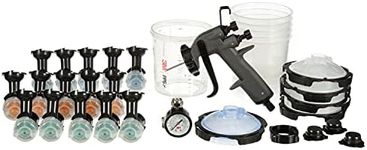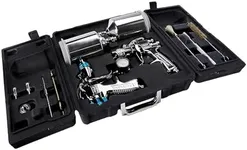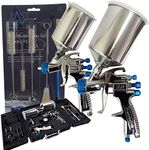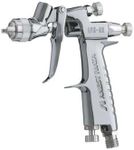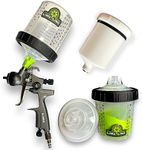Buying Guide for the Best Automotive Paint Guns
Choosing the right automotive paint gun is crucial for achieving a professional finish on your vehicle. The right paint gun can make the difference between a smooth, even coat and a blotchy, uneven mess. When selecting a paint gun, consider the type of projects you will be working on, the kind of paint you will be using, and your level of experience. Here are some key specifications to consider when choosing an automotive paint gun.Type of Paint GunThere are several types of paint guns, including HVLP (High Volume Low Pressure), LVLP (Low Volume Low Pressure), and conventional spray guns. HVLP guns are popular for their efficiency and reduced overspray, making them ideal for detailed work and beginners. LVLP guns use less air and are suitable for smaller compressors, while conventional spray guns offer high pressure and are often used for larger projects. Choose the type based on your project size and your compressor's capacity.
Nozzle SizeThe nozzle size determines the flow of paint and the spray pattern. Smaller nozzles (1.0-1.3 mm) are ideal for fine detail work and thinner materials like clear coats and base coats. Medium nozzles (1.4-1.7 mm) are versatile and can handle a range of materials, including primers and single-stage paints. Larger nozzles (1.8 mm and above) are best for thicker materials like high-build primers and heavy-bodied paints. Choose a nozzle size based on the type of paint and the level of detail required for your project.
Air Pressure RequirementsDifferent paint guns require different air pressures to operate effectively. HVLP guns typically require lower air pressure (10-20 PSI) at the nozzle, which reduces overspray and waste. Conventional guns may require higher pressures (up to 50 PSI). Ensure your air compressor can deliver the required pressure consistently. If you have a smaller compressor, an LVLP gun might be more suitable as it operates efficiently at lower pressures.
Material CompatibilityNot all paint guns are compatible with all types of paint. Some guns are designed specifically for water-based paints, while others are better suited for solvent-based paints. Check the manufacturer's specifications to ensure the gun you choose can handle the type of paint you plan to use. This is important to avoid clogging and ensure a smooth application.
Cup SizeThe cup size refers to the container that holds the paint. Smaller cups (under 600 ml) are lighter and easier to handle, making them ideal for detailed work and smaller projects. Larger cups (over 600 ml) hold more paint, reducing the need for frequent refills, which is beneficial for larger projects. Choose a cup size based on the scale of your project and how often you are willing to refill the paint.
Ergonomics and WeightThe ergonomics and weight of the paint gun can affect your comfort and control during use. Lighter guns are easier to handle and reduce fatigue, which is important for extended painting sessions. Look for a gun with a comfortable grip and balanced weight distribution. If possible, try holding the gun before purchasing to ensure it feels comfortable in your hand.


